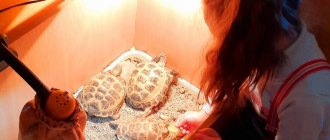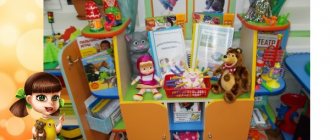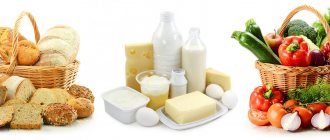Organization of a duty corner in kindergarten
Duty duty is one of the effective forms of organizing the work of children in a preschool institution. An original and brightly decorated duty officer's corner will help make duty more exciting, as well as streamline its implementation.
Beautiful, comfortable desk corners can now be ordered from various manufacturers, design agencies, and on the Internet. They will select both color and shape to order. But sometimes it is much more interesting for a creative teacher to make a corner with his own hands. After all, in this way he can show his talents and attract children, which will have a positive impact on the development of creative abilities and nurturing the diligence of children.
The teacher’s imagination and skill allow him to create interesting compositions from scrap materials, for example, from plastic dishes
Why is a duty corner necessary?
In addition to the aesthetic function of decorating the group room and delighting the students, a corner is necessary for many other reasons. The main tasks it performs:
- Encourage children to want to participate in work activities. Sometimes a child, who is not particularly eager to help, waits for duty and diligently fulfills his duties, because in the picture in the corner his name is indicated by his favorite cartoon or fairy tale character. The teacher should select pictures taking into account the children’s preferences; in this case, they will be on duty with great pleasure, because they want to be like their adored character.
- Involve in daily regular work. Children should know that work duties are performed one at a time, but as a team. This fosters both hard work and responsibility, as well as a sense of justice and camaraderie (today I help friends, set tables, tomorrow they will do the same for me).
- To develop the ability to work with symbols and signs: cards with pictures, names, tables with schematic images of table settings, the order of actions encourage children to active mental activity.
- Foster organization, composure, and develop logic. Carrying out duties according to a certain algorithm does not mean that children cannot look for more rational ways to perform work tasks. For example, while on duty for classes, children are convinced that it is more convenient when one person on duty lays out one type of material, for example, sketchbooks, and the second one lays out paints or pencils. This helps not to get confused in actions, and to complete the assigned task faster and with better quality.
- Instill accuracy and the ability to take care of yourself. The person on duty should be an example for other children, because he is an assistant teacher, and smart aprons and caps, always clean and ironed, will be an incentive for those on duty to want to take care of their appearance.
Cleanliness and neatness are wonderful qualities, and such an elegant duty area contributes to their education
Dependence of the design of the corner on the age of the children in the group
Duty corners are necessary in all groups except early age (third year of life). Before you start making a corner, you need to think about what it will be like, take into account all the requirements that apply to it, and also decide where to place it.
One of the main functions of such a corner is to help the teacher organize the sequential participation of all children in the group on duty and report who is on duty today in different areas of activity. Since different types of duty become available to children at different ages, the teacher should first of all pay attention to this point.
The first thing children are introduced to is canteen duty. It is introduced in the second junior group, but not at the beginning, but in the middle of the year. During the first half of the year, children master labor skills by completing assignments: arranging napkin holders and plates for bread. Instructions are given to one or two children, the children perform the same actions, guided by the prompts of the teacher or nanny's assistant.
In the younger group there is enough a corner for dining room duty, decorated with the children’s favorite characters and cute pictures
The second type of duty is introduced in the middle of the year in the middle group. This is class duty. Beforehand, children become familiar with the work performed on this duty and also through assignments. They lay out handouts, plates for appliqué, plasticine, etc. on the tables, and after class they collect them and bring them to the designated place. Instructions are given to those who want to help, so not all children in the group are involved in the work. That’s why duty is so useful, as it allows all students to be involved in work.
In the middle group there will be enough corner for two duties: for the dining room and for classes
The last to be introduced is duty in a corner of nature. It begins in the older group in September, since children of this age know how to quickly navigate, have sufficient skills and abilities, and are able to divide labor operations among themselves, perform them together, and help each other.
Thus, the type of duty corner depends on the age of the children who will be in the group, because pupils are placed not haphazardly, but taking into account the height of the furniture (tables, chairs) that is located in the group room:
- If children of the second youngest group will live in the room, then a corner for duty in the dining room will suffice.
- In the group where the middle school children will be, a corner is made for canteen duties and classes.
- If the group room is equipped with sufficiently high furniture or the furniture is adjustable in height, satisfying the sanitary requirements for older preschoolers, then such a group requires a corner for those on duty for all three types.
Requirements for the duty corner in kindergarten
In addition to taking into account the age of children, when making a corner for duty officers, the following requirements must be observed:
- Durability and reliability. Since the corner is made not for a week or a month, but for a long period, its preservation should be ensured during this time. Therefore, for the base it is worth choosing a durable material, such as plywood or chipboard. Plastic or cassettes for pasting the ceiling can serve as a good replacement for these materials. When purchasing them at a hardware store, you must definitely ask for a certificate stating that this type of material can be used inside residential premises. Paper, even whatman paper, will not last long; the only other option is very thick, high-quality cardboard.
- Possibility of wet cleaning. All equipment in the group (especially long-life equipment) must be wet cleaned according to the schedule. This does not mean that the corner will be washed with soap, but it is necessary to wipe it from dust with a damp sponge. Therefore, inscriptions and drawings on its surface must be indelible.
- This can be achieved if you use multi-colored self-adhesive film, EVA material, or plastic for decoration.
Foamed rubber, or EVA, is an excellent material for the design of a kindergarten group: it can be cut, glued, and can withstand wet cleaning
The bright painted corner of the attendants looks great against the background of a simple plain wall
Not a requirement, but advice: place the corner where direct sunlight will not fall on it during the day. This will protect the background and cards from fading and keep them looking attractive longer.
Contents of the duty corner
The main, most striking and attention-grabbing component of the duty corner is, of course, a stand on which information about the duty officers will be posted. Attached to the stand is a set of pictures or photographs of children, which, for better preservation, it is advisable to laminate with transparent film.
To be on duty in the canteen you must have the following equipment:
- A brush for sweeping crumbs from the table, about 25–30 cm long together with the handle. The handle should be no more than 3 cm in diameter, comfortable for a child’s hand.
- A dustpan for crumbs, measuring about 15 by 15 cm, with a handle up to 12 cm long. The dustpan and table brush are stored suspended on hooks and are not placed on the floor under any circumstances.
- A floor broom for sweeping with a handle length of up to 110 cm and a cross-section of up to 3 cm.
- Garbage scoop with long or short handle. These tools are stored near the corner, but not in the vicinity of the clothes of the attendants.
Equipment for sweeping crumbs off tables should be stored hanging on hooks
A broom is not used for sweeping in kindergartens, it is difficult to disinfect, and its use does not comply with sanitary standards.
The clothes of the dining room attendants consist of aprons, which can be made from chintz, guipure, satin, preferably in light colors. Headwear for girls: scarves, caps. Boys are offered only caps.
Craftswomen - mothers and grandmothers of pupils - will help make aprons and caps for the attendants
For duty in a corner of nature, purchase waterproof aprons and, if possible, sleeves. To care for plants you need the following equipment:
- watering cans;
- basins for washing plants;
- sticks for loosening the soil;
- sponges for wiping leaves.
Diagrams and step-by-step images of the actions of duty officers, pictures and photos of correctly set tables can complement the design of the duty corner.
In order for the duty officers to properly understand the duty schedule, an explanation from the teacher is necessary
Class duties do not require special clothing or equipment. The main thing that students should be equipped with is the ability to quickly and organizedly carry out the assigned work. In the senior and preparatory groups, a lot of material is used in classes, so children need to be collected and be able to clearly perform actions (take and place plates, lay out oilcloths, etc.), because not much time passes from breakfast to organized educational activities, and sometimes the teacher really needs the help of those on duty.
Master class “Duty corner in the middle group”
Elena Semyonova
Master class “Duty corner in the middle group”
Organizing duty in kindergarten is an important part of the labor education of a preschooler. Indeed, from preschool age, every child must take part in work, perform simple duty duties , since duty instills in children such qualities as hard work, discipline, and accuracy. Thanks to this, children become more confident in their actions. Today, the duty corner in kindergarten is designed mainly by the hands of teachers. So I decided to organize a duty corner in my group . For the base I took a ready-made canvas
I printed out the letter templates and cut them out.
Using these templates, I cut out letters from foamiran.
I bought ready-made pockets from an advertising agency.
I pasted pre-printed pictures onto the pockets (optional)
To decorate the corner, I sewed an omelette with sausage from felt (for the appetite)
I designed cards with personalized pictures of children (since children cannot read)
I poured cereal into baby food jars
Decorated with felt berries (isn’t it delicious)
All that remains is to assemble everything into one whole (glued with double-sided tape)
The process of labor education will become more exciting if the duty corner is decorated colorfully .
Of course, I didn’t forget about aprons and the duty (I printed it from the Internet)
I hope with such a corner, the duty itself will turn into an interesting game.
Duty corner in kindergarten: do-it-yourself design ideas
Marina Yakovleva 12/22/2017 5 14.2k
Preschoolers love to work and help their elders and friends. Their work is filled with rich content and plays a great educational role if organized using an aesthetically designed duty corner that takes into account the requirements of the program and the age characteristics of children. The teacher can make and equip the corner with everything necessary with his own hands, relying on the support of the students’ parents, as well as involving the children in this.
Some interesting ideas for decorating duty corners
As a rule, the stand, that is, the base of the corner, is made in the form of a panel on which the name, pockets for pictures-signs (or photos) and decorative elements are located. Several design ideas will help to diversify and make the corner unusual.
There are usually no difficulties with the name of the duty officers’ corner, since in most groups it is called that way: “Duty duty corner.” There are also options: “We are on duty, they are on duty today.” But how much more interesting and useful in terms of the development and upbringing of children is to name the corner “We love to be on duty”, “Little Helpers”, “Hardworking Suns, Bees, Daisies” (depending on the name of the group).
The kids will definitely want to know what the inscription means, and it will be much more pleasant to hear in response not just a phrase, but praise. This will create a desire to participate in the labor process and may even serve as the topic of a fascinating educational conversation: “Why do you think our corner is called that? Who is called hardworking? How can you help the teacher, the nanny, your group friends?”
There are also several options for individual symbol cards:
- Figured: in the form of flowers, clouds, mushrooms with an individual picture and the child’s name. In this case, the stand itself should be designed accordingly - like a lawn, a sunny sky, a clearing in the forest.
- With fastening on stud buttons. In this case, pictures indicating the types of duty are placed on the stand, and under them there are buttons with a protruding plastic part, the so-called studs. In this case, children's cards are made with loops or slits, hanging them on buttons. The buttons must be secured to the stand securely, not just by sticking them in, but additionally secured with superglue so that they do not fall out and cause injury.
- In the form of flags. Under the pictures of those on duty in the dining room, nature and activities there is a shelf, and on it there are two holders for flags for each type of duty. Individual pictures or photos of children are glued onto the flags and inserted into the holders.
Photo gallery: examples of designing duty corners in kindergarten for different age groups
The duty corner helps organize and interest children in regularly performing work duties. A colorful, attractive corner, made by the hands of a teacher from inexpensive improvised materials, will definitely arouse the interest of little fidgets and will help make the work process easy and fun - after all, children or their relatives, handicrafts mothers and skillful fathers will definitely take part in the design of the corner.
Sources:
https://www.maam.ru/detskijsad/-ugolok-dezhurnyh-i-ugolok-nastroenija-svoimi-rukami.html https://www.maam.ru/detskijsad/master-klas-ugolok-dezhurstva-v- srednei-grupe.html https://melkie.net/oformlenie-gruppy/ugolok-dezhurstva-v-detskom-sadu-oformlenie.html




